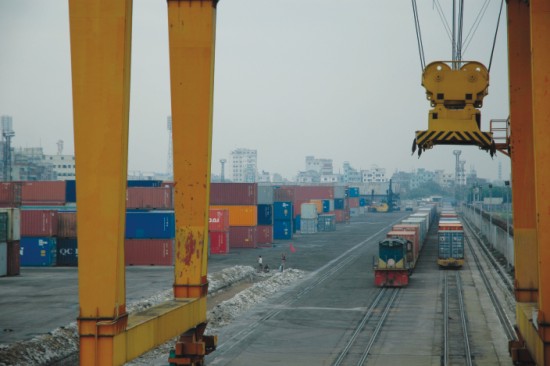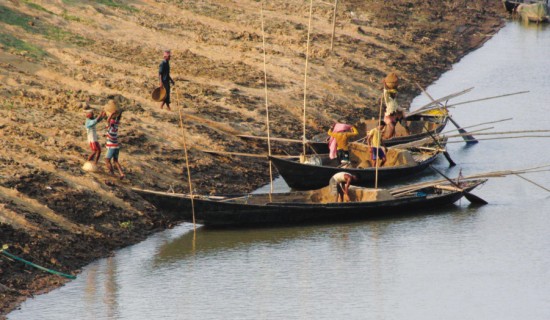
Inside
|
Running the Numbers K.A.S. Murshid breaks down the potential benefits of cooperation What exactly did the prime minister achieve on her recent visit to India? For the time being, all we can say with some certainty is that there has been an exchange of vows between the two sides -- a very good start to any relationship. Let us also remind ourselves that it has taken us more than 38 years to get this far. One hopes that it will not take another 38 years to translate these into action. While there is a broad agreement in place now on many issues, the list is by no means complete. One does get an impression that the agenda was driven by India although that does not mean that we do not stand to gain -- as long as this really marks a new beginning and a will to resolve all outstanding problems equitably. In other words, we need to adopt a longer term perspective and take into account the huge potentials and possibilities that now lie dormant but which could be released given the right conditions. In the more immediate term, much will hinge on the specific terms and arrangements that are put into place in terms of protocols surrounding transit-trade facilitation, charges and levies, and the infrastructure and management systems that will be needed.
We will need to demonstrate that Bangladesh actually stands to benefit significantly even in the shorter term. Benefits will not flow automatically however, but will require careful handling and mature bargaining. To put it differently: we should act quickly, but not in haste; we will need to do our homework well so that we can negotiate effectively. Let us not give away our wickets like our batsmen are wont to do! Development Strategy and India However, we are not naïve -- we know that the market is not infallible and can sometimes mislead and even collapse -- this is true of the stock market, and this is true of the rice market. We have thus decided to provide hefty subsidies to agriculture, and promised to build strong, "inclusive" safety nets, etc. One should add that we have done well by some standards (growth rates, female education) and not so well by others (poverty, malnutrition, governance). The challenge now is to grow rapidly a la China and India at say 8-9 percent a year. For this to happen, we need investment, we need markets, we need power and gas, and we need to reduce corruption. This is the backdrop against which we must measure the significance of the Bangla-Indo agreement. India is a global economic power. We run a very large trade deficit with India (over $1 billion -- incidentally, our deficit with China is much larger at around $2.5 billion), and we find it excruciatingly difficult to break into the Indian market. And, of course, this is surpriing because we do quite well in the world market, even with our few products. This makes us very unhappy neighbours. The promise made by Dr. Manmohan Singh to lift non-tariff barriers and allow greater market access to our products would need to be implemented quickly to create the right conditions for genuine cooperation. (Cynics note that previous promises of a similar nature have remained firmly locked up in bureaucratic red tape). Our long-term strategy must surely be to align ourselves with the two economic powerhouses of Asia, namely India and China, and given our geography, particularly with India. We also need to clearly understand what exactly it is that India is trying to achieve through transit facilities. India's goal is not just to connect up with a remote, neglected, poor, discontented although resource rich part of its country to the mainland. It is in fact eyeing direct connectivity with the Far East using the North-East (via Bangladesh) as a gateway. The strategy is closely tied to Indian efforts to conclude an Indo-Asean FTA which has finally borne fruit (the FTA has come into effect from January 1, 2010). Thus, the stakes are potentially high, where Bangladesh is well poised to carve out a share of the pie. The whole region could soon witness a major spurt in economic activity, where the role of Chittagong port could be pivotal. Bangladesh needs to do everything possible to ensure that it will profit from the regional action likely to be unleashed, in addition to whatever revenues it can earn through transit trade. For example, Bangladeshi investors should be able to invest in India (including in the North-East) -- the joint communiqué asserts that "investments, including joint investment and joint ventures, shall be encouraged by both countries." Bangladesh should also pro-actively set up a string of Special Economic Zones along the North-Eastern border states with a view to tapping its rich resources. The Chinese and Vietnamese have used these to great advantage. There is no reason why we could not profit from their long experience. In the short-term however, we will need to consider how best and at what terms we should open up to the transit-trade market. Options Security
Pilferage and Smuggling The pat answer that one hears from talk show experts is that we should containerise the traffic, whether it is by road or rail. This, it is argued, will prevent pilferage and ensure unhindered flow. This however, is easier said than done. Containers are expensive and than done. Containers are expensive and require special infrastructure and handling. Moreover, relatively high value freight is moved by containers while the bulk of the demand for transit is likely to be low value products like coke, rice, sugar and cement. Thus, containerisation will automatically reduce the demand for transit to relatively few higher value items like tea and consumer durables. Road or Rail? According to the Roads and Highways division, transit traffic by road should only be allowed once the roads have been upgraded to at least national Standard Grade II level. This will require an investment of $168 million for the Benapole-Tamabil route, via Dhaka (excluding the cost of the Padma Bridge) and $370 million for the Banglabandh-Tamabil route via Jamuna Bridge. Upgradation, however will take many years. Quite apart from the large investments required, trucks are likely to be more prone to disappear along the way. The impact on traffic congestion, road safety, the environment, and operation and maintenance costs will also be sizeable -- costs that the rail option can easily avoid. Bangladesh railways will also need to be upgraded and aligned with the Indian railways in order to avoid the costs and delays of frequent transshipment en route. The Indian credit line promised would seem to be adequate to cover the major infrastructure expenses that will be needed, for both the road and rail systems. However, it is only the latter that should be opened up to transit traffic. This is also an excellent opportunity to develop the moribund BR and ease pressure on our congested roads. Costs and Delays Clearance time for imports from India by truck or rail takes something like 7-15 days. In addition, transit traffic will be subject to a number of transshipments as it moves from say broad gauge to meter gauge, or if ferries have to be used. Each time that this occurs it will add to cost and time. Thus, the cost-time advantage of transit through Bangladesh could be significantly eroded unless the system is made efficient. This in turn will affect what we can charge for transit freight.
The charges should be fixed according to the principal of opportunity cost, with a discount to attract business. Local transport operators or the BR should charge market rates without discriminating against local freight. The difference between the operator's rate and the discounted opportunity cost should be charged by the NBR as a government levy. The exact levels of these charges will no doubt be the subject of tough negotiations. Transit Traffic The Indian freight carried by Indian North-Eastern railways is predominantly low value bulk products like food-grain and cement, along with small quantities of other goods (inward to the North-east), and coal-coke, and mineral oils (outward). Direct data on road traffic from/to the North-East could not be found -- if anyone knows of a decent source, please give us a shout!. The road to rail freight traffic ratio in both Bangladesh and India is 60:40 in favour of roads. There is no reason why the situation in the North-East would be different. On the basis of this assumption, we estimate road freight movement to be around 25 million tons. Thus, the total inland trade between the Seven Sisters and mainland India is likely to be in the region of 40 million tons per annum travelling a distance of say 1,000-1,500 km. We could assume that at least 50 percent of this traffic could be routed through Bangladesh, if the facilities were appropriate. A significant proportion of demand would be for container freight as well, especially for high value products like tea, fresh meat, fish, fruits and vegetables, textiles, wood products etc. As already noted BR is not ready to take up this huge challenge, and would need massive upgradation of capacity, technology and infrastructure. If our strategy is to focus only on high value freight through container traffic, the challenge is even greater. Let us assume that investments have been made and we are ready to handle significant volume of freight. What sort of revenues could we then expect to earn? Let us provide some back-of-the-envelope estimates: If we assume that only a quarter of the transit demand will be met, this would be 10 million tons. Of this let us say that 2.5 million tons will be mid-high value freight (e.g. lifted by trucks) and the remaining is bulk freight by rail. By rail, transit of bulk cargo via Bangladesh would come to $11 a ton compared to the $30 a ton presently. By truck, the cost would be $150 a ton in place of $50 a ton, bypassing Bangladesh. Let us assume that we agree on an equitable split of the gains, i.e. charge $19.5 per ton for bulk freight and $100 per ton for high value goods. This then yields the following revenue: $146.25 million for bulk freight (of which $71.25 million accrues to NBR) and $250 million for high value products (of which $125 million will accrue to NBR). In other words we are talking about revenue earnings of up to $400 million a year of which almost half will accrue to NBR. However, these are optimistic figures since other costs have not been accounted for, namely cargo handling, customs inspections, insurance for damage/pilferage, documentation forwarding, time cost of delays and bank processing of LCs -- which together, could be quite substantial. Thus, gains to Bangladesh will not be automatic but will depend on efficiency and reduction of transactions costs and delays. The default option will be economically insignificant and politically costly. Dr. K.A.S. Murshid is a Research Director at BIDS and heads the BIDS Policy Resource Program.
|


